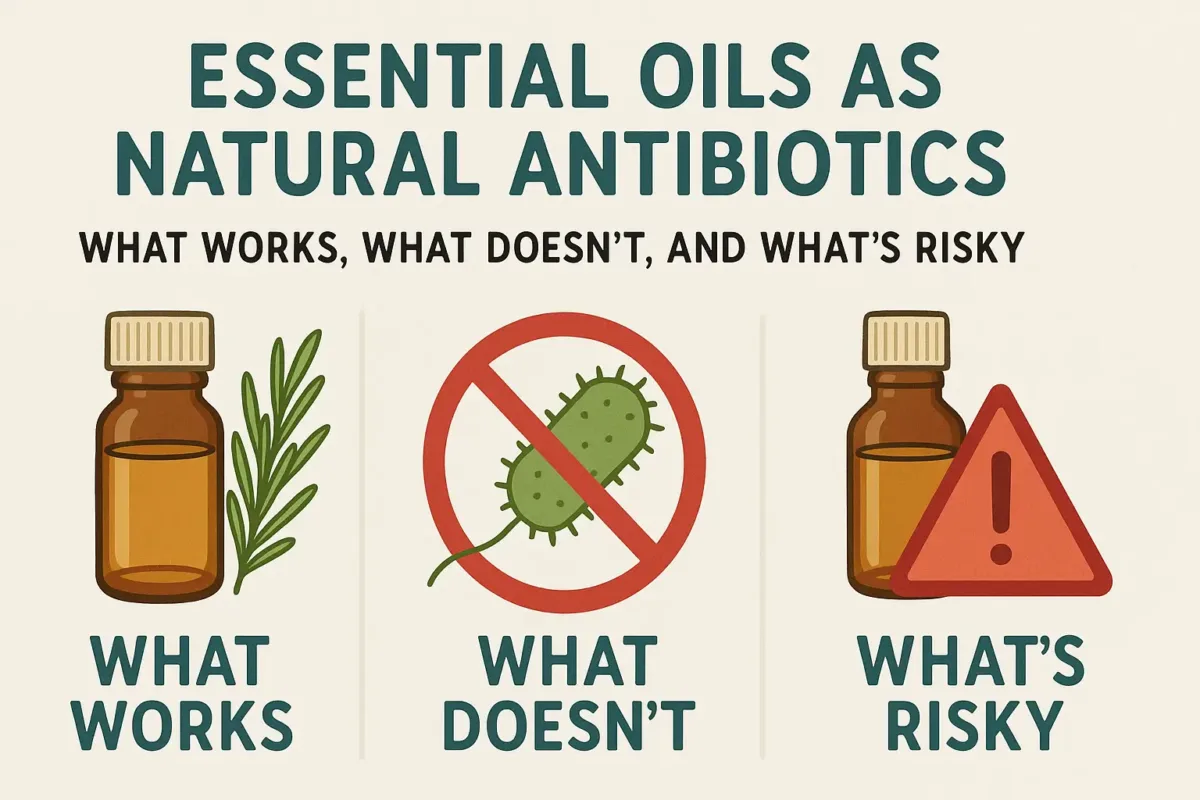Essential oils as natural antibiotics is a phrase that stirs both hope and confusion. For thousands of years, humans leaned on the protective chemistry of aromatic plants to clean wounds, fight spoilage, and calm coughs. Frankincense smoke drifted through temples, thyme steeped in hot water cleared winter lungs, and clove soothed dental pain in crowded ports. Today, research is catching up to what tradition noticed: certain essential oils do have measurable antimicrobial effects. But between promise and practice lies a narrow bridge between safety, dosage, and context. This guide is that bridge—calm, clear, and grounded in both science and lived wisdom.
- The Science in Plain Language: How Aromatic Molecules Fight Microbes
- What Actually Works: The Most Researched Antibacterial Essential Oils
- What Doesn’t Work (or Isn’t Worth the Hype)
- What’s Risky: Internal Use, Overexposure, and Sensitive Groups
- Safe Dilution: The Non-Negotiable Step
- Evidence‑Informed Use Cases (Practical, Respectful, Realistic)
- Why They Sometimes Help When Nothing Else Does
- And Why They Sometimes Don’t
- Quality Matters: Chemotypes, Adulteration, and Labels
- Myths to Retire
- The Nervous System Link: Aroma, Safety, and Immunity
- When to Stop Home Care and Seek Help
- FAQs
- Can essential oils replace antibiotics?
- Which essential oils have the strongest antibacterial activity?
- What is a safe dilution for skin?
- Is internal use ever safe?
- Can I diffuse oils daily?
- Which carrier oils work best?
- Are essential oils safe in pregnancy?
- Do essential oils help with biofilms?
- What should I do if skin becomes irritated?
- How do I spot quality oils?
The Science in Plain Language: How Aromatic Molecules Fight Microbes
Essential oils are concentrated plant extracts rich in volatile compounds such as terpenes (e.g., limonene), phenols (e.g., carvacrol, thymol, and eugenol), and aldehydes (e.g., cinnamaldehyde). In the plant, these chemicals deter insects, molds, and bacteria. In the lab, they disrupt bacterial cell membranes, make it harder for microbes to communicate via quorum sensing, and can penetrate biofilms—the slimy protective layers that allow pathogens to resist cleaning agents and some drugs.

But a crucial distinction matters: petri-dish potency doesn’t equal safe human dosing. The concentrations used in vitro often exceed what skin can tolerate or what’s prudent to inhale long-term. A wise approach honors both sides—evidence and physiology.
What Actually Works: The Most Researched Antibacterial Essential Oils
Across dozens of studies, several oils consistently demonstrate meaningful antibacterial or antifungal activity when used appropriately:
- Tea Tree (Melaleuca alternifolia): Broad-spectrum activity for acne, mild fungal issues, and wound cleansing. Dilute to 1–2% in a carrier oil. Never apply inside ears or on mucous membranes.
- Oregano (Origanum vulgare): Rich in carvacrol and thymol, showing strong effects even against some resistant bacteria. Extremely potent—use 0.5–1% topically and avoid internal use without clinical supervision.
- Thyme (Thymus vulgaris, chemotypes thymol or linalool): Antibacterial and antiviral; supportive in respiratory blends when properly diluted.
- Clove (Syzygium aromaticum): Eugenol offers analgesic and antimicrobial benefits, particularly for dental discomfort. Use sparingly (≤0.5%).
- Cinnamon Bark/Leaf (Cinnamomum verum): Potent antibacterial; best reserved for environmental cleaning blends due to high skin‑irritation potential.
- Lavender (Lavandula angustifolia): Gentle antiseptic and skin regenerator; complements stronger oils by calming inflammation and improving tolerance.
Other helpful allies include eucalyptus, rosemary, and lemongrass—especially in diffusion for air hygiene and short, seasonal support.
What Doesn’t Work (or Isn’t Worth the Hype)
Some marketing claims overshoot reality. “Immunity blends” with mostly citrus oils smell uplifting but contribute little antibacterial strength compared to tea tree, thyme, or oregano. Likewise, applying undiluted lavender on every cut or diffusing oils all day won’t replace good hygiene, nutrition, and rest. Essential oils are adjuncts, not silver bullets.
What’s Risky: Internal Use, Overexposure, and Sensitive Groups
Because a single ounce of essential oil can represent pounds of plant material, internal use is risky without expert guidance. Cases of liver injury, seizures, and severe irritation have been documented from inappropriate ingestion or heavy diffusion. Topical overuse can chemically burn skin, disrupt the skin barrier, and trigger allergic reactions. Special populations require extra caution:
- Children: Use gentler oils at very low dilutions; avoid peppermint for infants, and use diffusers sparingly with ventilation.
- Pregnancy: Avoid high-phenol oils (oregano, clove, and cinnamon) and consult professionals before any use.
- Respiratory conditions or epilepsy: Some oils can be triggers; seek personalized guidance.
- Pets: Cats and birds are particularly sensitive; ensure fresh air and avoid direct exposure.
Safe Dilution: The Non-Negotiable Step
Skin is not a piece of paper; it’s living tissue. Proper dilution respects that. General guidelines for healthy adults:
- Face/fragile skin: 0.25–0.5% (1–3 drops per 2 teaspoons carrier oil)
- Body applications: 1–2% (6–12 drops per 2 teaspoons)
- Short‑term spot use (adult): up to 3% for stubborn areas, then reduce
- Children/elderly/sensitive: 0.1–0.5%
Carriers such as jojoba, sweet almond, or fractionated coconut oil increase comfort and reduce irritation. Always patch‑test the inner forearm first.
Evidence‑Informed Use Cases (Practical, Respectful, Realistic)
1) Blemish & Minor Skin Irritation (Tea Tree + Lavender)
Blend 1 drop tea tree and 1 drop lavender into 2 teaspoons jojoba (≈1%). Dab once daily for 3–5 days. Stop if redness worsens.
2) Post‑Shave or Ingrown‑Prone Skin (Thyme linalool + Aloe)
Mix 1 drop thyme linalool in 2 teaspoons aloe‑jojoba gel (≈0.5%). Apply thinly; the goal is harmony, not sting.
3) Short Diffusion for Seasonal Air Support (Thyme + Eucalyptus + Lemon)
Diffuse 3–5 drops total in a well‑ventilated room for 30 minutes, then pause. Never run diffusers continuously.
4) Environmental Cleaning Spray (Cinnamon leaf + Clove + Lemon)
Add 10–15 total drops to 8 oz (240 mL) 70% alcohol or vinegar solution for surfaces. Do not spray on skin.
5) Foot or Nail Hygiene (Oregano very diluted)
Use 1 drop oregano in 2 tablespoons oil (≈0.1%) around, not under, nails. Apply 2–3x weekly for short cycles, monitoring for irritation.
Why They Sometimes Help When Nothing Else Does
Essential oils can penetrate biofilms and interfere with bacterial signaling. This explains anecdotal reports of improvement where standard cleansers fail. Their lipid‑soluble molecules reach places water‑based agents can’t, and when combined with good hygiene and rest, they may tip the scales back toward balance.
And Why They Sometimes Don’t
They are not systemic antibiotics. Oils stay largely where they’re applied or inhaled. If you’re dealing with a deep tissue infection, high fever, spreading redness, or chest pain, seek medical care immediately. Natural doesn’t mean sufficient—context is medicine.
Quality Matters: Chemotypes, Adulteration, and Labels
Two bottles with the same plant name can behave differently. Thyme ct. thymol is stronger and more irritating than thyme ct. linalool. Cheaper products are sometimes diluted with synthetic fragrances or carrier oils without disclosure. Buy from brands that provide batch testing, Latin names, harvest region, and chemotype.
Myths to Retire
- “Undiluted is more effective.” It’s more irritating and can backfire by damaging skin—your first defense.
- “If a little helps, a lot will cure.” Dose‑response with oils is non‑linear; overdoing it increases risk without proportional benefit.
- “All natural products are safe for kids and pregnancy.” Potent phenols and ketones are contraindicated for many.
The Nervous System Link: Aroma, Safety, and Immunity
Calm isn’t a luxury; it’s part of immunity. Pleasant aromas signal safety to the nervous system, nudging the body toward the parasympathetic state where repair happens. A short diffusion ritual before bed—lavender with a hint of cedar—can improve sleep, which in turn improves immune responses. Healing is never one molecule; it’s a network of cues.
When to Stop Home Care and Seek Help
- Worsening pain, spreading redness, pus, or fever
- Breathing difficulty, chest tightness, dizziness
- Rash, hives, or swelling after application—wash off and seek care
- Symptoms persisting beyond a few days despite rest and hygiene
FAQs
Can essential oils replace antibiotics?
No. They can assist with minor, localized issues but do not replace prescribed antibiotics for serious infections.
Which essential oils have the strongest antibacterial activity?
Tea tree, oregano, thyme (thymol or linalool chemotypes), clove, and cinnamon show robust activity in lab studies.
What is a safe dilution for skin?
Generally 1–2% for adults (6–12 drops per 2 teaspoons carrier oil). Use 0.25–0.5% on the face or sensitive skin.
Is internal use ever safe?
Only under qualified clinical supervision. Ingestion can damage organs or interact with medications.
Can I diffuse oils daily?
Short, ventilated sessions (20–45 minutes) are safer. Avoid continuous diffusion and ensure pets and children tolerate it.
Which carrier oils work best?
Jojoba, sweet almond, or fractionated coconut oil are stable, skin‑friendly options.
Are essential oils safe in pregnancy?
Many are not. Avoid high‑phenol oils and seek personalized guidance.
Do essential oils help with biofilms?
Some (e.g., oregano, thyme) show biofilm‑disrupting activity in vitro; this may support hygiene when used properly.
What should I do if skin becomes irritated?
Stop use, wash with mild soap, and apply plain carrier oil. Seek care if burning or rash persists.
How do I spot quality oils?
Look for Latin names, chemotypes, batch numbers, GC/MS testing, and transparent sourcing. Avoid vague “fragrance oils.”
Essential oils are not miracle bottles. They’re concentrated whispers from resilient plants—powerful when respected, risky when rushed. Used with care, they can help the body remember balance.
If this spoke to you, you’ll love the full information in this book; begin your deeper reading → See the book on Mayobook.


